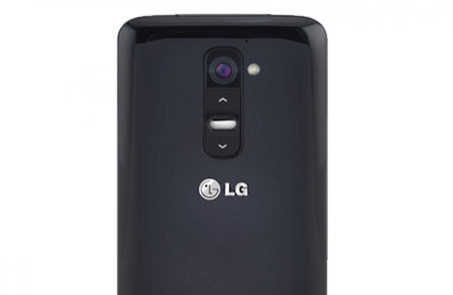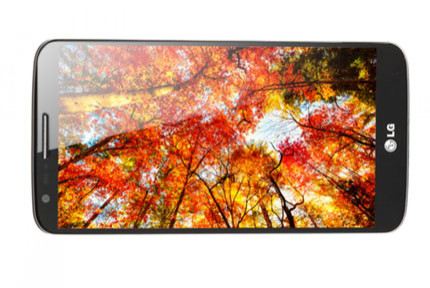LG G2: The Top 3 Best And Worst Features In LG’s New Flagship, Hands-On
LG introduced its G2 phone to the world at an event in New York City on Wednesday. The specs of the smartphone were unveiled -- but the South Korean manufacturer has not announced the LG G2’s release date and price.
LG manufactured the Nexus 4 for Google (NASDAQ:GOOG), and there are rumors that the Korean manufacturer will include some of the G2's features in the next Nexus phone. However, more convincing reports have Motorola, a Google company, producing what some are pegging as the Nexus 5.
Whether or not the LG G2 is a first draft of the next Nexus, the International Business Times got a chance to spend some time with the device. After taking some time to mull over what the LG (who you callin' Optimus) G2 has to offer, we offer you a review of its new features.
The Bad:

1) Rear Key: buttons on the back
The standout design feature of the LG G2 is the large phone’s power and volume buttons -- placed on its backside. LG calls it the Rear Key, but we call it an unnecessary solution to a nonexistent problem.
The company touts the Rear Key as more natural than side buttons. A left- or right-handed person naturally places the index finger in the back of the phone, LG says. In theory, this might be a great idea -- but in practice, it falls flat. The Rear Key also prevents the phone from laying flat on a surface.
The LG G2’s width, at 2.7 inches, is ideal for mostly all users, the company said. So perhaps the Rear Key is a way to market the LG G2 as a phablet that even users with small hands can use and enjoy, but in our hands-on time with the device, it felt unintuitive and clunky.
The LG G2 offers a new feature called Knock Knock -- a double-tap on the front of the LG G2 brings the device out of sleep mode. LG said that it was developed so that if the G2 is lying on its back (hiding access to the Rear Key), users can still turn the screen on and off. In reality, Knock Knock is another solution to an unnecessary issue, and did not work all that well in our hands-on demonstration.
Perhaps the Rear Key will prevent accidental button-pressing when handling the LG G2, but in essence, it fails to improve the smartphone experience.
2) Only 2 gigs of RAM
One of the more exciting rumors about the LG G2 was that the phone might hold 3GB of RAM, compared to the 2GB found in most high-end flagship devices. It turned out to be false -- the G2 will ship with 2GB, the same amount found in the Nexus 4.
We do not expect LG to tailor its hardware specifications to every rumor floating around its Internet. But 3GB of RAM would have made the G2 a standout in an industry where the current trend is to market lower-end specs like a 720p screen or a dual-core processor as “good enough” for most users.
RAM is essential to multitasking on any computing device, smartphones included. More RAM allows for faster swapping between apps, and less lag when there are several open. The combination of a fast quad-core processor with more RAM than any other device on the market would have made the LG G2 a real powerhouse.
3) Software innovations are not innovative
LG made the G2 with a clear focus on hardware. Most of the new software features in the G2 were completely unnecessary.
Slide Aside is a perfect example. A three-finger swipe arrays the open apps in a windowed array to the side of the screen. While this might be useful on a desktop computer, it offers no benefit or function not available from two of the three buttons found at the bottom of the phone.
Slide Aside lets you use an awkward three-finger swipe to see the home screen, but there is already a Home button for that. It also allows for a zoomed-out view of the last three windows you opened, but there is already a Multitask button for that.
Basically, Slide Aside, like many of the new UX features in the LG G2, is gimmicky and not particularly useful.
The Good:

1) The gorgeous 5.2-inch display
The LG G2 has a big screen, with a bezel measuring less than one tenth of an inch. It is full HD (1080p), and offers 423 pixels per inch (PPI). The IPS LCD screen is bright and beautiful, and offers a lot of real estate for apps or watching videos.
LG set up the G2 next to the Samsung Galaxy S4 and the iPhone 5 -- without displaying the phones outright. The LG representative said the company had not tinkered with the display settings on the competing flagships, but the setup was rather unscientific. In comparison, the LG G2's background was whiter, giving colors more pop and making text easier to read.
2) A powerful quad-core processor
The LG G2 offers a 2.26GHz quad-core Krait 400 CPU, coupled with an Adreno 330 GPU. The powerful main processor makes for a fast experience on the LG G2, whether you are playing a game or browsing the web. The Snapdragon 800 SoC should help the LG G2 stand out among its peers on its release date.
3) A capable battery
A powerful processor and bright screen could do a lot of damage to a phone’s battery life over the course of the day. The LG G2 will pack a 3,000mAh battery, which should help it last through a day of heavy use. Additionally, LG gave the G2 a SiO+ battery.
SiO+ are batteries developed by LG that contain silicon oxide (SiO) instead of the graphite component in traditional lithium-ion batteries. This means a partial increase in the battery’s capacity, somewhere in the neighborhood of 6 percent.
The bottom line
The LG G2 is a powerful phone, with a great display and a battery capable of handling the load. The LG G2 is sleek enough, and not unwieldy with one hand despite its sleek display. However, the key design feature in the LG G2 is the Rear Key -- which presents more problems than it solves, and fails to improve the smartphone experience.
Let us know what you think in the comments. Is the LG G2 a dud or a revolutionary device?
© Copyright IBTimes 2024. All rights reserved.





















